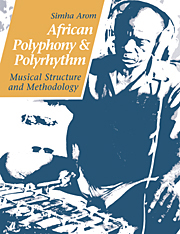Book contents
- Frontmatter
- Contents
- List of illustrations
- Foreword by György Ligeti
- Preface
- Acknowledgements
- BOOK I THE MUSIC OF THE CENTRAL AFRICAN REPUBLIC
- BOOK II AFRICAN POLYPHONIC MUSIC
- BOOK III TECHNICAL TOOLS: METHODS OF RECORDING POLYPHONIC MUSIC FOR TRANSCRIPTION
- BOOK IV THEORETICAL TOOLS
- 1 The notion of relevance
- 2 Description and analysis
- 3 The question of transcription
- BOOK V THE ORGANISATION OF TIME IN AFRICAN MUSIC
- BOOK VI STRUCTURAL PRINCIPLES AND THEIR APPLICATION
- Conclusion
- Bibliography
2 - Description and analysis
Published online by Cambridge University Press: 27 January 2010
- Frontmatter
- Contents
- List of illustrations
- Foreword by György Ligeti
- Preface
- Acknowledgements
- BOOK I THE MUSIC OF THE CENTRAL AFRICAN REPUBLIC
- BOOK II AFRICAN POLYPHONIC MUSIC
- BOOK III TECHNICAL TOOLS: METHODS OF RECORDING POLYPHONIC MUSIC FOR TRANSCRIPTION
- BOOK IV THEORETICAL TOOLS
- 1 The notion of relevance
- 2 Description and analysis
- 3 The question of transcription
- BOOK V THE ORGANISATION OF TIME IN AFRICAN MUSIC
- BOOK VI STRUCTURAL PRINCIPLES AND THEIR APPLICATION
- Conclusion
- Bibliography
Summary
INTRODUCTION
In the preceding chapters, we have insisted on the fact that the music we are considering here is always based on a system or code. We should, of course, recall that ‘a code has two essential parts: a set of elements and a set of rules defining how these elements must operate and combine’ (Ruwet 1966, 1972: 102). It is therefore obvious that a code implies a theory, and we have already indicated several times that the theory is implicit rather than explicit in traditional African music. All the investigator will encounter there at first are sets of elements, messages.
His description can thus only start from sets of messages, each characterised by a cluster of relevant features which distinguish it from the others in the same cultural setting. Let us also recall that, in Central Africa, these sets are generally musical categories or special repertories defined by a social function, a particular vernacular name, a certain vocal and/or instrumental ensemble, and very often, a characteristic rhythmic formula.
The first step of a description is to pick out what distinguishes each set of messages from all the others, to determine what characterises it, and discover its relevant features. The way the elements comprising each of the pieces in the set are organised must also be determined: in their syntactic aspect, the individual parts in polyphony, and in the aspect of musical simultaneity, the poly-phonic and poly-rhythmic combinations. At the next lower level, the description should provide a characterisation of each operational unit in each part in a given piece, i.e., it should define the smallest formally relevant elements, or ‘morphemes’. This stage of the description proceeds from the whole to its parts and is strictly analytic.
- Type
- Chapter
- Information
- African Polyphony and PolyrhythmMusical Structure and Methodology, pp. 157 - 169Publisher: Cambridge University PressPrint publication year: 1991



